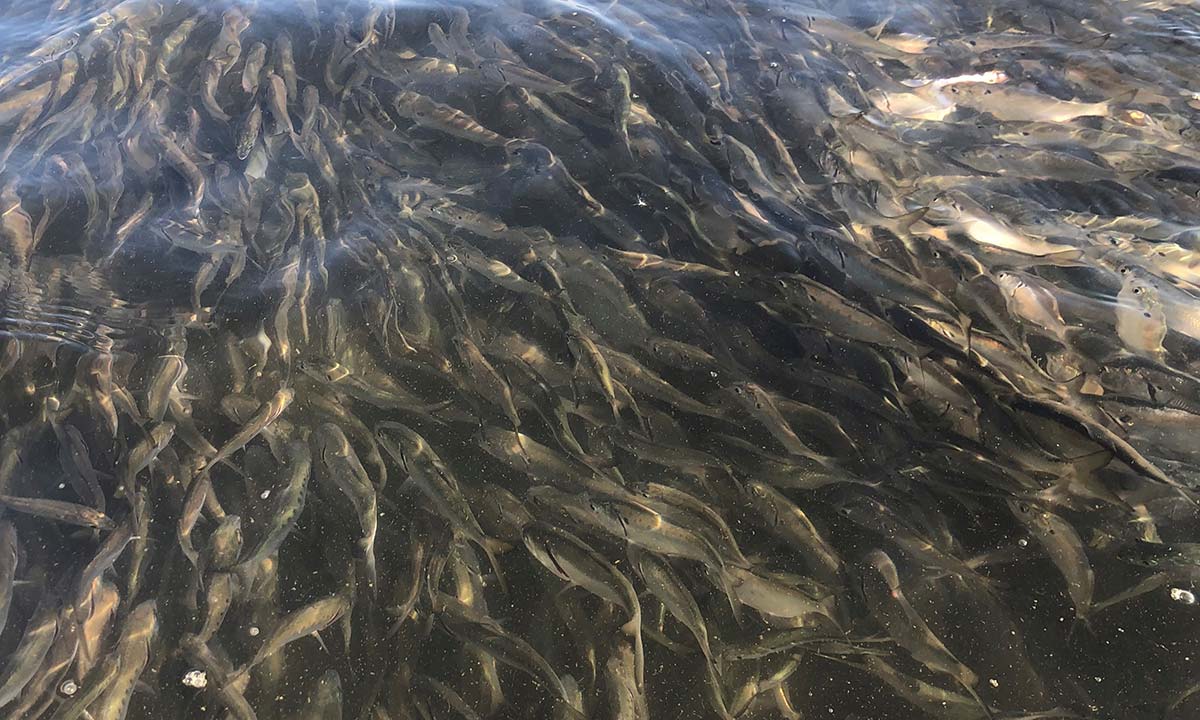
An often overlooked opportunity awaits many anglers in South Jersey as the weather cools and the calendar turns to October. Anyone creeping around the bridges, bulkheads and abandoned docks – especially at night – will find nature’s fall bounty.
Like the prospectors who first found gold in California, I thought I’d hit the “motherlode” the first time I came across them still hanging around into October. Peanut bunker were just about everywhere. Almost every street that dead ends at the back bay held them. The bridges that connect our barrier islands attract them; the boat docks nearly vacant for the winter are loaded with them. And at night, lit up by lampposts, bridge lights or dock lights, even more fish gather.
Peanut bunker are not a new bait, and they’ve been choking our lagoons and canals since August. But in recent years we’ve have seen more juvenile menhaden residing contently in our back bays through October and even into November. You can watch them as they circle around, tightly packed, in the clear, shallow waters. Besides the “David Attenborough” moments of natural wonder and amazement, there is a real opportunity to use these baits to your advantage this month as blues, weakfish and stripers feast upon the seemingly endless supply of high caloric morsels swimming in tight circles.
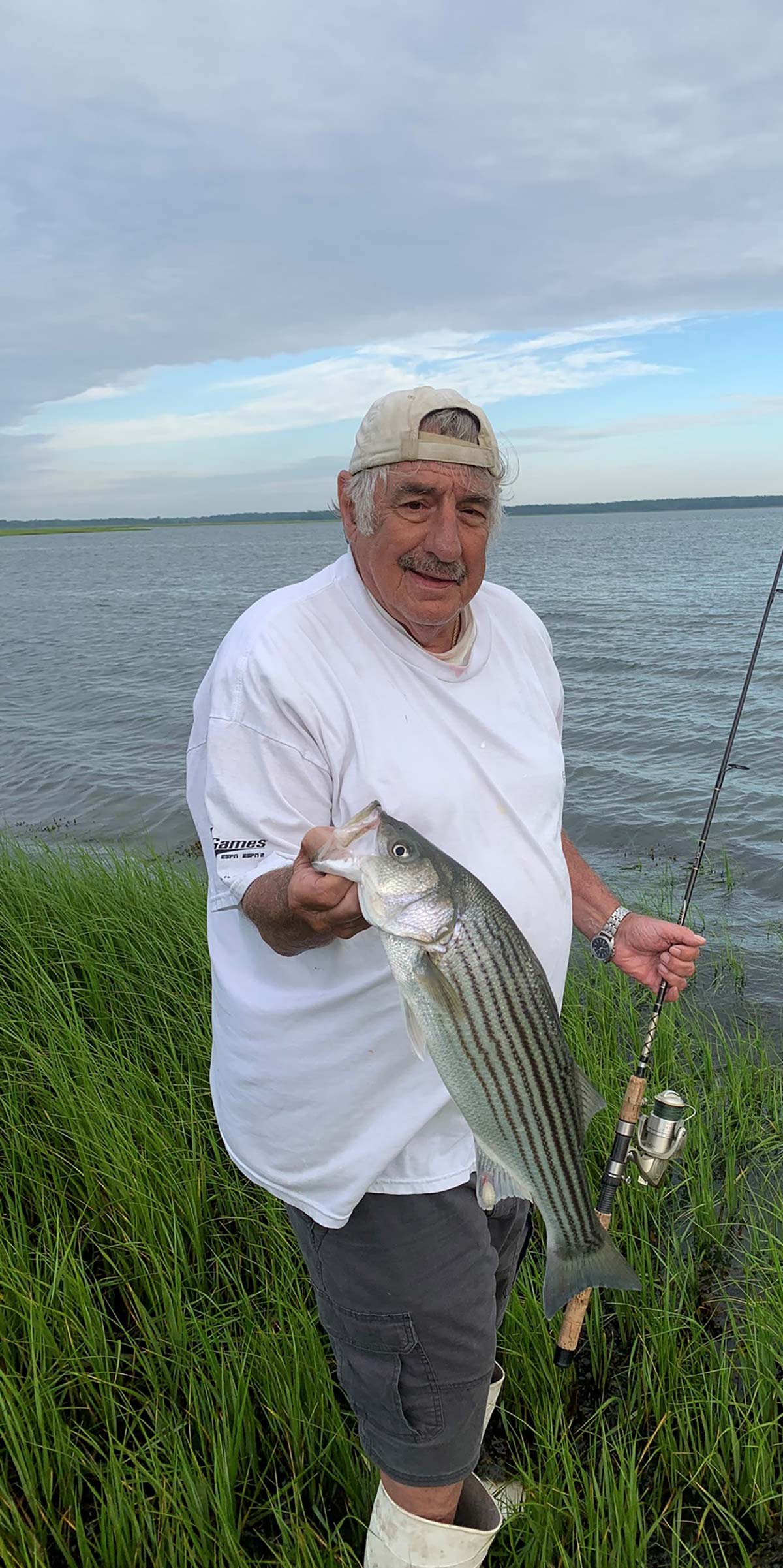
The Real Thing
I love artificial lures; I like looking at them, I like collecting them and I like using them. Sometimes to my own detriment. Poppers, swim baits and soft plastics will take a few fish here and there, but there is nothing more frustrating than having bait schools right in front of you with fish feeding on them and your fancy artificials not getting a second look. Don’t listen to me, go ahead and bring along your smallest spooks, shortest Mag Darters, and a selection of 4-inch soft plastic jerk shads just in case. But like the song says; “there ain’t nothing like the real thing baby.”
When the universe gives you peanut bunker, use them (never argue with Mother Nature!) Specifically, using these baby bunker while they are alive can often give you an edge on most any artificial offering. Peanuts can be snagged with small weighted treble hooks, then transferred to a circle hook, but this reduces their useful lifespan by at least 75%. That’s why having a cast net and knowing how to throw it is essential (and there are only about a million videos online that can show you how).
When casting a net around docks and bulkheads for peanuts or finger mullet, a 5-foot net is more than large enough. For years I used a 3-footer; it’s easier to throw in small spaces like boat slips. At this time of the year, the bait is packed so densely and you only want to take what you can keep alive, there’s no need for a larger net. I specifically target the outside of the school as I only need about a dozen baits if fishing alone. I’d rather have 12 fresh lively baits than 30 dead ones. Cast net only what you can keep alive for the amount of time you’re fishing.
They are a delicate bait that do not last long unless you put very few in a bucket, change the water frequently and use an aerator to keep the water oxygenated. Overcrowding will kill them faster than anything. For a 5-gallon bucket, one dozen baits is about the max. The water and air temperatures will also have a huge effect on how long your baits will stay lively without needing to change out the water.
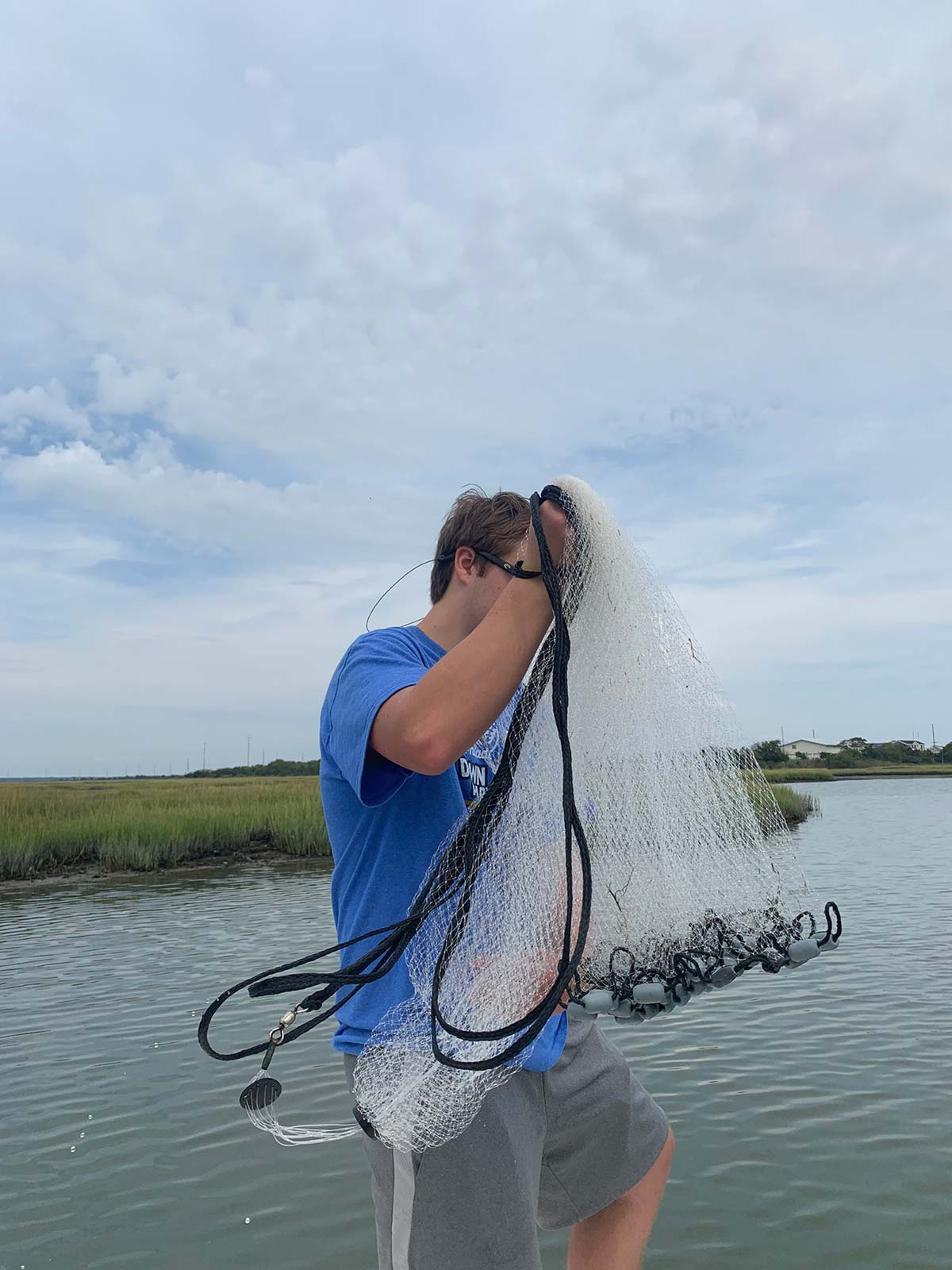
Fish ‘Em, Near Or Far
Peanut bunker, even the larger ones up to 6 inches, are a very delicate bait. That’s why, whenever possible, I prefer fishing in the same area where I catch my peanuts. Here, you know there is plenty of bait to attract gamefish, and you might even see the fish flashing from time to time to get away from those larger gamefish. Of course, the schools of peanut bunker you’re netting might also be devoid of gamefish with the bunker just hanging out, filter feeding, without a care in the world. If this is the case and you are not fishing where you caught them, it will take a bit of planning in order to transport these baits to your honey hole. That can be a nearby jetty, inlet, bridge or just some other area where there may be less bait but more hungry fish. Luckily, the transport materials list is not large.
Start with two lidded 5-gallon buckets, both with enough rope attached to the handle to reach the water where you are harvesting your bunker (and where you plan to fish). Two buckets are necessary as the water needs to be replenished at least three times per hour depending on temperature (the warmer the water temperature, the faster the dissolved oxygen is depleted). As soon as your baits start to look lethargic or gasping at the surface, you are 10 minutes past the point where you should have drained the old water and added new water. Don’t let it happen again!
A bubbler/aerator is a good addition to this setup but even the strongest aerator won’t keep these baits alive for very long without the water being refreshed. It will however buy you some time when transporting from one area to another. A Bubble Box portable air pump by Marine Metal Products is compact, inexpensive and will run on two D batteries for hours. You’ll also find a full line of “bubblers” and bait coolers from Engel Coolers that will capably fit the bill for carrying your peanuts along on road games.
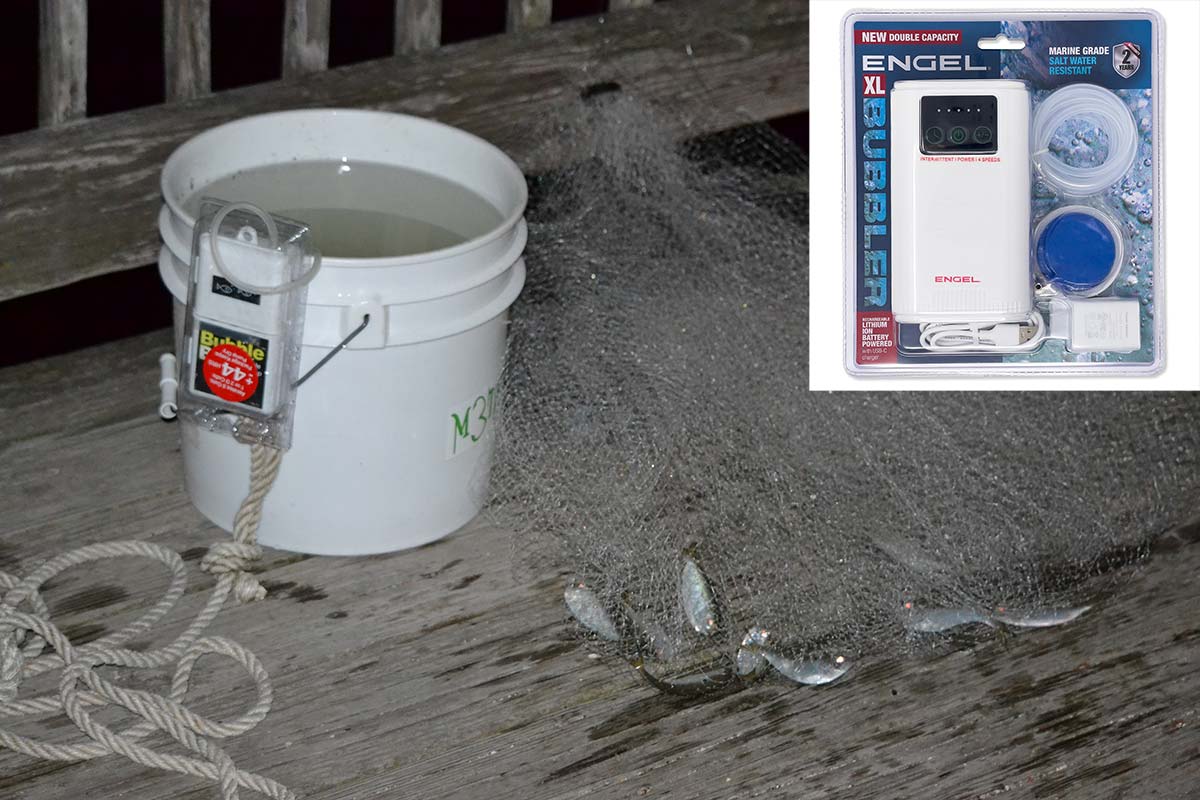
Livelining Options
When livelining these baits in the back bay, I normally don’t add any weight at all and prefer to just let the peanut do its thing. It will try to regroup with a pod, but the line drag and the hook piercing its lips will make it stand out in the group. Exactly what you want if you know that gamefish seek out the weak and injured. If there is wind or current, or when fishing deeper waters, I may add a couple of split shot to my line to keep the bait off the surface of the water. Again, the bunker will not only be fighting line drag and the hook, but those extra split shot might put them right into the feeding zone.
When fishing deeper water, over 10 feet or so, like along a bridge, jetty or seawall, I’ll send the bunker to its fate using a slip bobber and split shots. This is a technique borrowed from walleye fishing that I’ve used successfully for over 25 years at the Jersey Shore. When using a slip bobber, it is very important to constantly adjust the depth you are fishing until you find where the fish are feeding. This is especially true of weakfish which, if your bait isn’t cruising around at just the right depth, they will ignore your offering. Many times I find weakfish, especially this time of the year, to be hanging out in the middle of the water column. Fishing a bait on the bottom in this situation won’t get you a second look.
The slip bobber setup also comes in handy when fishing the western edges of the barrier islands with an easterly wind. The fish might be out of casting range, but you can easily use the wind to float your offering well past the distance you’re limited to with your cast.
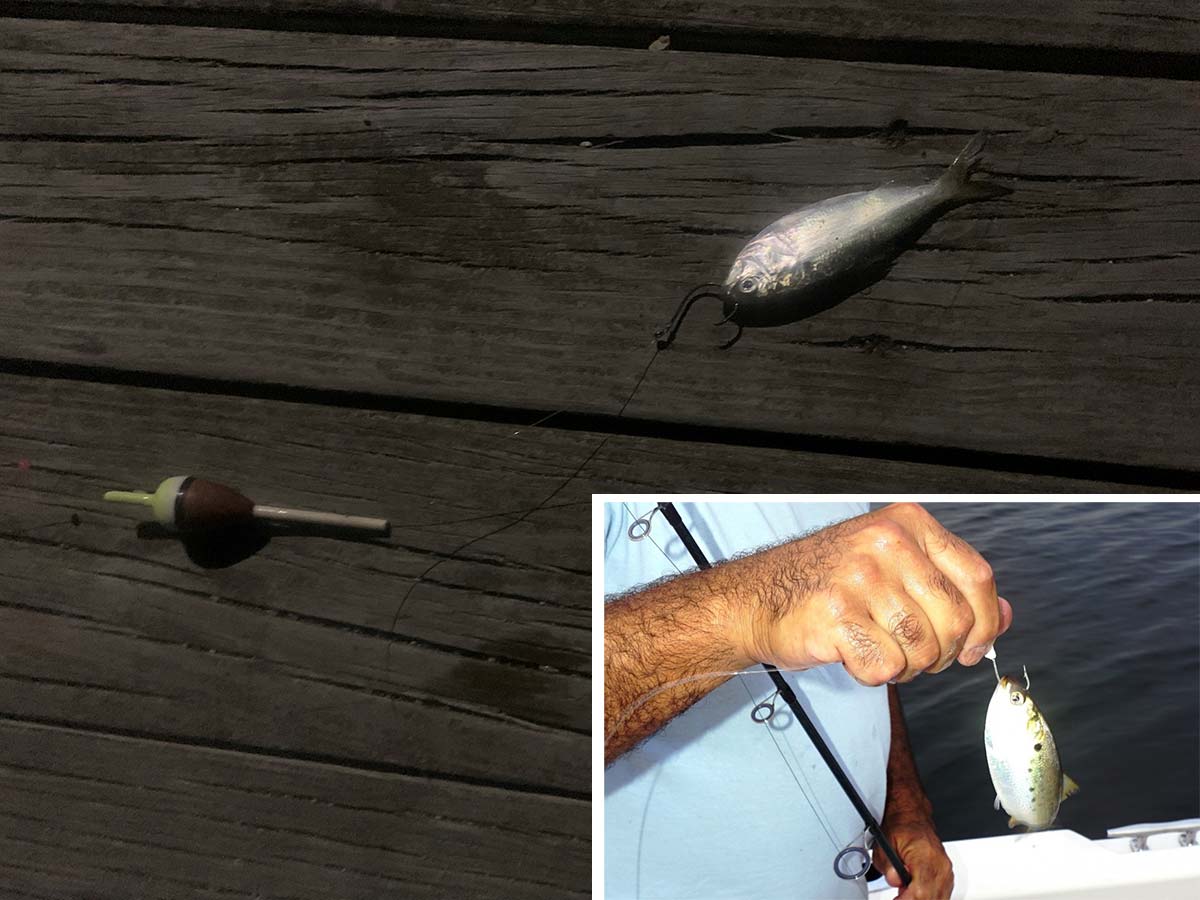
If tying the slip bobber rig, start with tying a bobber stopper to your main line. Next, thread a small bead (comes with the stopper), then the slip bobber on your main line. Don’t forget to adjust your bobber stop to the depth you would like to fish. Tie your main line off to a crane or barrel swivel.
To the swivel, attach 24 inches of 15- to 20-pound fluorocarbon leader material. To this add your light wire, in-line circle hook. Gamakatsu or Eagle Claw make strong light wire hooks in the 2/0 to 3/0 size, perfect for rigging peanuts. Be sure to snell your circle hook correctly. Any old knot will hold, but to get the most effective hook set, I suggest using the power snell. When first using circle hooks, I’d tie them on using my go to knot, the Trilene Knot. Since switching to the power snell for circle hooks, my hookup rate has dramatically improved.
Any way you decide to rig your peanut bunker (top lip, bottom lip, both lips, tail, dorsal, etc.) your tackle choices will be the same. I use a Shimano Sustain 4000 spooled with 20-pound Berkley X9 braid; if you have a similar sized reel with a baitrunner feature, even better, but not necessary. That reel is paired with a 7-foot medium light power rod rated for 10- to 20-pound test and 1/4- to 3/4-ounce lures. More importantly, that rod’s action is in the moderate/fast range.
This is not a dedicated livelining outfit. It serves multiple purposes as it is also my go to for tossing leadheads tipped with soft plastics or live peanuts, as well as bucktails, small swim baits or poppers. The extra length and light action assists in delicately tossing out a fragile peanut. As the bait is so fragile, just a lob is really all that’s needed most of the time to get your bait into the strike zone.
| TIMES & TIDES |
| As we are harvesting the baitfish from the back bays in relatively shallow water, I try to time my outings so I can start fishing (or gathering bait) during the last two hours of the incoming tide. During this time, the peanuts will be within cast net range as they try to get as far as possible away from deep water where stripers, weakfish and blues are patrolling. If fishing the back bays, I’ll fish the two hours before high, slack high, and the two hours after high. When transporting the bait and fishing deeper water locations, tide is just not as important; in fact, some of my best days of livelining peanuts for weakfish came from a jetty in the fall at dead low tide. – A. Califano |
Once casted, I’ll either hold the road with the bail open, or if putting my rod down, I’ll give my drag knob two full turns to loosen it. This will allow the line to easily peel off the spool when a fish picks up my bait. As soon as the line starts coming off my spool, I then just have to either flip the bail or make two full turns on the drag to be back in fighting mode. Once that bail is flipped or the drag is tightened, the rod bows and the circle hook usually finds the corner of the fish’s mouth as designed.
When fishing the backwaters in October, the majority of fish caught will probably be resident stripers in the schoolie to 24- to less than 28-inch New Jersey Striped Bass Bonus Program size range. While transporting these live baits to your favorite jetty, bulkhead or bridge will take more effort, that effort is usually rewarded with weakfish and much larger migratory stripers, especially if fishing at night.


